D-1: Difference between revisions
Pbcjohnston (talk | contribs) (Added D-1 page) |
Pbcjohnston (talk | contribs) m (→In Service) |
||
| (19 intermediate revisions by 2 users not shown) | |||
| Line 1: | Line 1: | ||
D-1 photos | [[File:D-Boat Header 1.jpg]] | ||
__TOC__ | |||
=== Under Construction === | |||
[[File:D-1 build 1.jpg|left|500px]] | |||
<div style="text-align: justify;"><span style="color:#00008B">Narwhal under construction at Fore River Shipbuilding, Quincy, MA., May 9, 1908. These boats were built inside a large construction shed, enabling very fast building times. The D-class were single hull submarines that had all of the tankage inside the pressure hull. The Electric Boat design utilized a patented "U-shaped" ballast tank design amidships, the frames of which can clearly be seen here. The boat's battery cells would sit on the bottom of the "U" with a walking deck installed above the cells, right where the curved top of the tank went vertical. It was a very innovative tank design that provided a lot of internal space. This photo shows only the middle part of the boat, which would become the battery compartments and the control room. The frames for the torpedo room and the engine rooms have not yet been installed. | |||
<small>Photo courtesy of the Submarine Force Library & Museum.</small> | |||
[[File:Red bar sub new.jpg]] | |||
[[File:D-1 build 2.jpg|left|500px]] | |||
Another photo taken later on the same day shows progress in building the Narwhal. This view is looking from forward to aft. Just beyond the U-shaped ballast tank structure workers have installed the lower framework that will become the foundations for the engines. In the foreground can be seen the curved frame that will form the gasoline tanks under the torpedo room. | |||
<small>Photo courtesy of the Submarine Force Library & Museum.</small> | |||
[[File:Red bar sub new.jpg]] | |||
[[File:D-1 build 3.jpg|left|500px]] | |||
This photo of Narwhal construction was taken 10 months later, on February 7, 1909. Rapid progress has been made. The pressure hull is complete and most of the superstructure has been installed. Narwhal is on the left, Grayling is on the right, in a lesser state of completion. On Narwhal, the superstructure curves around the bow to form the stem, but there is a gap between the stem and the beginning of the pressure hull around the torpedo tubes. The rotating bow cap will be installed there. | |||
<small>Photo courtesy of the Submarine Force Library & Museum.</small> | |||
[[File:Red bar sub new.jpg]] | |||
[[File:D-1 build 4.jpg|left|500px]] | |||
A different view of the same scene above, still with a view of the incomplete bow of Narwhal, February 7, 1909. | |||
<small>Photo courtesy of the Submarine Force Library & Museum.</small> | |||
[[File:Red bar sub new.jpg]] | |||
[[File:D-1 build 5.jpg|left|500px]] | |||
Another angle of the bow area of Narwhal under construction, February 7, 1909. This gives a very clear view of the muzzle end of the torpedo tubes. The streamlined rotating bow cap will be installed later. The cap has two holes in it that will line up with two of the tubes diagonally so that those two tubes can be fired. The cap is then rotated to open up the other two tubes. After firing, the cap is rotated so that the two holes are aligned vertically, and the cap is pulled back and seated firmly so that it seals the muzzle ends of the tubes. The tubes can then be drained and the breech doors inside the torpedo room opened when the boat returns to port. The D-class only carried four torpedoes and no reloads. | |||
<small>Photo courtesy of the Submarine Force Library & Museum.</small> | |||
[[File:Red bar sub new.jpg]] | |||
[[File:D-1 build 6.jpg|left|500px]] | |||
This view of Narwhal's bow while under construction on February 7, 1909 also shows that the conning tower fairwater has been built atop the superstructure in the middle of the boat. | |||
<small>Photo courtesy of the Submarine Force Library & Museum.</small> | |||
[[File:Red bar sub new.jpg]] | |||
[[File:D-1 build 7.jpg|left|500px]] | |||
An interior view of Narwhal while under construction at the Fore River Shipbuilding yard in Quincy, MA. This photo was taken on June 12, 1909. The view is from the forward battery area looking forward toward the torpedo room. A large square portion of the torpedo room bulkhead has not yet been installed. See pictures below for what it will look like when complete. The breech doors of the torpedo tubes are open. Yard workers have loaded torpedo "shapes" (inert, non-functioning torpedo simulators) into the tubes to check fit and finish. The two large angled pipes leading upward from the deck right at the bulkhead are battery ventilation pipes that vent hydrogen and heat from the battery while it is being charged. The boat is nearing completion at this point. She would be commissioned five months after this photo was taken. | |||
<small>Photo courtesy of the Submarine Force Library & Museum.</small> | |||
[[File:Red bar sub new.jpg]] | |||
<div style="text-align: justify;"><span style="color:#000000"> | |||
=== Interior Photos === | |||
</div> | |||
[[File:D-1 torp room 1.jpg|left|500px]] | |||
<div style="text-align: justify;"><span style="color:#00008B">The following series of internal photos of Narwhal were taken just before or just after her commissioning in November 1909 and show the boat in a completed and pristine state. This is the bank of torpedo tubes. The breech door of each tube is opened by rotating the large handwheel. The doors swing outboard. The large handwheel at top center is used to unseat the bow cap and move it forward a few inches so that it can rotate. Actual rotation is achieved by cranking the lever in the middle. The levers at the top on each side are for firing the tube. Pulling the lever will shoot an impulse of high-pressure air into the back end of the tube, pushing the weapon out. | |||
<small>Photo courtesy of the Submarine Force Library & Museum.</small> | |||
[[File:Red bar sub new.jpg]] | |||
[[File:D-1 torp room 2.jpg|left|500px]] | |||
This is Narwhal's torpedo room looking aft. Compared to the photo above, the photographer essentially just turned around. You can see here that the bulkhead that was missing in the construction photo above has now been put into place, with the standard watertight door in the middle. Directly above the door is the circular opening of the angled torpedo loading hatch. | |||
<small>Photo courtesy of the Submarine Force Library & Museum.</small> | |||
[[File:Red bar sub new.jpg]] | |||
[[File:D-1 torp room 2A.jpg|left|500px]] | |||
This is a closeup of the photo above, showing the view through the torpedo room watertight door, looking aft into the forward battery compartment and the control room. The ladder seen in the background leads up to the conning tower, and the large levers are for the ballast tank Kingston valves. This view plainly shows that there was not a bulkhead to separate the forward battery from the control room. It was one big compartment. | |||
<small>Photo courtesy of the Submarine Force Library & Museum.</small> | |||
[[File:Red bar sub new.jpg]] | |||
[[File:D-1 forward battery 1.jpg|left|500px]] | |||
For this photo the photographer stepped through the torpedo room watertight door, turned to the left, then shut the door behind him. This is the forward starboard corner of the forward battery space. On the left is the shut door to the torpedo room, and on the right is the boat's only commode. There is a suspended bar in the overhead that was for a curtain to provide the user of thre commode some level of privacy. The angled pipe against the bulkhead is a battery ventilation line, and it can be seen in the construction photo above that shows the bulkhead missing. | |||
<small>Photo courtesy of the Submarine Force Library & Museum.</small> | |||
[[File:Red bar sub new.jpg]] | |||
[[File:D-1 control room 1.jpg|left|500px]] | |||
This is the aft end of the Narwhal's combined control room and forward battery space. This view is looking at the aft port corner. The large wheel is the stern planes control station. The chain leads up to rod that leads back to the aft end of the boat to the stern planes themselves. The D-class only had stern planes so there is only one wheel. Two depth gauges are on either side of the wheel. On the left is the ladder leading up to the conning tower. Behind the ladder are the levers for operating the ballast tank Kingston valves. | |||
<small>Photo courtesy of the Submarine Force Library & Museum.</small> | |||
[[File:Red bar sub new.jpg]] | |||
[[File:D-1 control room 2.jpg|left|500px]] | |||
For this photo the photographer has stepped back a few steps so that he could image the periscope eyepiece. This was a non-retractable periscope, but was able to rotate the field of view by turning the large handwheel at the bottom. This instrument was a 4-inch diameter model made by Electric Boat. | |||
On the left of the photo is the open watertight door leading through the bulkhead to the after battery compartment. | |||
<small>Photo courtesy of the Submarine Force Library & Museum.</small> | |||
[[File:Red bar sub new.jpg]] | |||
[[File:D-1 control room 3.jpg|left|500px]] | |||
This view is looking aft and to starboard in the control room. On the right is the ladder to the conning tower. In the middle is the door to the after battery compartment. To the left of the door are the high-pressure air and ballast trim mainifolds. | |||
<small>Photo courtesy of the Submarine Force Library & Museum.</small> | |||
[[File:Red bar sub new.jpg]] | |||
[[File:D-1 control room 4.jpg|left|500px]] | |||
This is a better view of Narwhal's high pressure air and ballast trim manifolds in the starboard aft corner of the control room. | |||
<small>Photo courtesy of the Submarine Force Library & Museum.</small> | |||
[[File:Red bar sub new.jpg]] | |||
[[File:D-1 after battery 1.jpg|left|500px]] | |||
This photo was taken in the after battery compartment looking forward. This is the helm wheel. Very unusually, the designers placed it in the after battery compartment. The placement of the wheel here was dictated by the desire to have a watertight bulkhead separating the control room from the after battery. With the other equipment that was in the control room (stern planes control, ballast control, periscope station, etc.) the helm wouldn't fit so they placed it here. The mirror was used by the helmsman to see the dial of the magnetic compass that was above his head. The handwheel was connected to the steering shaft seen in the upper right by the geared belt and the rudder could be turned completely by hand if necessary, but there was also an electric assist motor in front of the helm (seen here painted black). The horn above the mirror was a voice tube that allowed the helmsman to speak with the Officer of the Deck in the control room or on the bridge. | |||
The second half of the boat's battery would be underneath the helmsman's feet, under the deck. | |||
<small>Photo courtesy of the Submarine Force Library & Museum.</small> | |||
[[File:Red bar sub new.jpg]] | |||
[[File:D-1 engine room looking aft.jpg|left|500px]] | |||
The next compartment aft is the engine room. This compartment is separated from the after battery compartment by a watertight bulkhead. This large compartment contains not only the EB/Craig gasoline engines, but also the clutches, the dynamo generator/motors, and the air compressors. This view is looking aft from the forward end of the compartment. | |||
<small>Photo courtesy of the Submarine Force Library & Museum.</small> | |||
[[File:Red bar sub new.jpg]] | |||
[[File:D-1 engine room looking aft 2.jpg|left|500px]] | |||
This is a little further aft in the engine room, showing the clutches in the foreground, and the motor/generators further aft. | |||
<small>Photo courtesy of the Submarine Force Library & Museum.</small> | |||
[[File:Red bar sub new.jpg]] | |||
[[File:D-1 engine room looking forward.jpg|left|500px]] | |||
This is from the aft end of Narwhal's engine room looking forward. The motor/generators are in the foreground, then the clutches, and finally the engines. Faintly seen in the far background is the watertight door leading to the after battery compartment. It is somewhat drowned out by light. | |||
<small>Photo courtesy of the Submarine Force Library & Museum.</small> | |||
[[File:Red bar sub new.jpg]] | |||
<div style="text-align: justify;"><span style="color:#000000"> | |||
=== In Service === | |||
</div> | |||
[[File:D-1 launch from bow.jpg|left|500px]] | |||
<div style="text-align: justify;"><span style="color:#00008B">Narwhal sliding down the ways at the Fore River Shipbuilding Company, Quincy, Massachusetts, April 8, 1909. The yard workers standing below and on both sides of the boat are in a perilous position. If any piece of the timber making up the launch cradle became stuck as the boat slid they could be injured or killed. There was also an off chance that the boat could fall off the launch cradle and crush them. It was rare to see men in these positions during a launch even in those days. | |||
<small>Photo courtesy of the Massachusetts Digital Commonwealth.</small> | |||
[[File:Red bar sub new.jpg]] | |||
[[File:D-1 haul out 1.jpg|left|500px]] | |||
Narwhal is seen here hauled out on the marine railway, right next to the shed where she was built at the Fore River Shipbuilding Company, Quincy, Massachusetts. The boat looks very new so this may have been a post-builder's trials haul out to fix issues found on the trials. This would place the date sometime in the summer or fall of 1909, but it could be any time before 1911. The bow cap for the torpedo tubes is very apparent in this photo, especially compared to the construction photos above. At the bottom of the hull just behind the bow cap there is an access plate that has been removed. This would lead into the forward trim tank. There was likely some sort of repair that needed to be done inside the tank. There is also an air or water hose connected to a fitting just aft of the access hole. | |||
<small>Photo courtesy of the Boston Public Library Print Department.</small> | |||
[[File:Red bar sub new.jpg]] | |||
<center> | |||
USS Narwhal (Submarine No. 17) crew muster for April 15, 1910. Data is incomplete due to missing or lost records. | |||
{| | |||
|+ Crew Muster April 15, 1910 | |||
|- | |||
| Townsend, Julius C. - Lieutenant - age 29 - Born: Missouri | |||
|- | |||
| Beisel, Fred C. - Midshipman - age 24 - Born: Illinois | |||
|- | |||
| Allen, Charles L. - CGM - age 27 - Born: Indiana | |||
|- | |||
| Davis, Fred - GM 1c - age 28 - Born: New York | |||
|- | |||
| Milligan, Joseph A. - GM 2c - age 23 - Born: North Carolina | |||
|- | |||
| Demont, Charles - GM 2c - age 23 - Born: Minnesota | |||
|- | |||
| Crilley, Lawrence - GM 3c - age 22 - Born: New Jersey | |||
|- | |||
| Powers, Richard J. - CMM - age 28 - Born: Connecticut | |||
|- | |||
| Bottleberghs, Frank J. - MM 1c - age 27 - Born: Belgium | |||
|- | |||
| Grisler, Charles A. - MM 1c - age 31 - Born: Pennsylvania | |||
|- | |||
| Herbert, John T. - MM 2c - age 21 - Born: Maryland | |||
|- | |||
| Miller, Ariel W. - MM 2c - age 22 - Born: Massachusetts | |||
|- | |||
| Kapp, Ernest E. - CEM - age 27 - Born: North Carolina | |||
|- | |||
| Blood, Walter H. - EM 1c - age 27 - Born: Pennsylvania | |||
|- | |||
| Peterson, Lars O. - EM 2c - age 22 - Born: Sweden | |||
|- | |||
| Lyons, William L. - EM 2c - age 25 - Born: Missouri | |||
|} | |||
<small>Thank you to Linda Talbott of the US GenWeb Census Project® for providing this information.</small> | |||
</center> | |||
[[File:Red bar sub new.jpg]] | |||
[[File:D-1 in nyc.jpg|left|500px]] | |||
D-1 moored at either the 79th Street or 135th Street piers in New York City, circa 1915. The rectangular opening in the forward superstructure is for a standard navy stockless anchor, and addition to the boat's normal keel mounted mushroom anchor. This modification was unique to D-1. The pipe frame and canvas bridge structure is in place over the conning tower fairwater, and there is a small dinghy on the aft deck. | |||
<small>Photo of the Submarine Force Library & Museum.</small> | |||
[[File:Red bar sub new.jpg]] | |||
[[File:D-1 with destroyers.jpg|left|500px]] | |||
D-1 moored in a nest of other submarines, with four 1000-ton four stack destroyers, [https://destroyerhistory.org/early/1000tonners/ '''probably Cassin-class ships'''], moored behind them. The location is likely at the Norfolk Navy Yard in Virginia, but it could be at any large Navy facility on the east coast. This is likely a wartime photo, 1914-1917. The D-1 seems to have at least one engine lit off, there is smoke coming from her muffler. This photo is actually the marriage of two photos in the Monroe County Library's collection. They were merged in the area of the life ring on the D-1 to show the whole scene. | |||
<small>Photos courtesy of the Monroe County Library Collection.</small> | |||
[[File:Red bar sub new.jpg]] | |||
[[File:D-1 stbd.jpg|left|500px]] | |||
D-1 underway off the New England coast, 1919-1920. By the time of this photo, D-1 had been re-engined with two 120-V4FS diesels, eliminating the noxious and dangerous Craig gasoline engines. A two masted schooner is barely seen in the haze in the background. About 12 or 13 crew are seen on deck which is just about the whole crew complement. There are probably one or two men below to run the engines. | |||
<small>Photo in the private collection of Ric Hedman.</small> | |||
[[File:Red bar sub new.jpg]] | |||
[[File:D-1 port bow.jpg|left|500px]] | |||
D-1 somewhere in transit along the U.S. east coast, approximately 1919. The purpose of the framework on the forward deck is unknown. It is sitting between the open torpedo loading hatch and the Allied Signal Bell. There is a bit of a swell running as the D-1 noses into a wave. | |||
<small>Photo in the private collection of Ric Hedman.</small> | |||
[[File:Red bar sub new.jpg]] | |||
[[File:D-1 at the pier.jpg|left|500px]] | |||
A really nice photo of the D-1 moored behind the train station, at the foot of State Street, in New London, Connecticut. The caption on the photo describes what is happening. "Taking on Gas". The date of the photo is likely late 1920 or early 1921. | |||
The tall church spire in the background is the First Congregational Church at the corner of State and Union. On the pier side to the right of the conning tower fairwater are two gasoline trucks, the right most is delivering gas to the submarine and the other is probably standing by to take over when the first has pumped their fuel into the submarine. | |||
The dark flag flying at the top of the #2 periscope is probably a homemade red "Bravo" flag signaling to those around that a fueling operation is going on. | |||
On January 25th, 2024 at 1:29 PM the steeple of the church, seen above, collapsed into the building destroying the 174 year old church, built in 1851. The church was currently owned by Engaging Heaven Church but still shared with the First Congregational Church. The remaining structure is being demolished. This landmark is now gone. | |||
<small>Photo in the private collection of Ric Hedman.</small> | |||
[[File:Red bar sub new.jpg]] | |||
<center>[[D-class|Return to the D-class page]] | [[Submarine Classes|Return to the Submarine Classes page]]</center> | |||
[[File:Red bar sub new.jpg]] | |||
<center> | |||
<span style="color:#00008B"> | |||
Page created by:<br> | |||
<small>Ric Hedman & David Johnston<br> | |||
1999 - 2023 - PigBoats.COM<sup>©</sup><br> | |||
Mountlake Terrace, WA, Norfolk, VA<br> | |||
webmaster at pigboats dot com</small> | |||
</center> | |||
[[File:Subs bottom line 2.jpg]] | |||
Latest revision as of 20:19, 4 November 2024
Under Construction
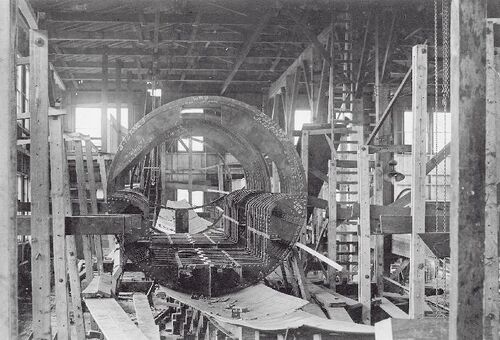
Photo courtesy of the Submarine Force Library & Museum.
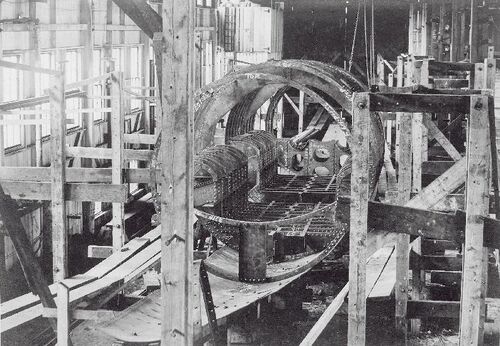
Another photo taken later on the same day shows progress in building the Narwhal. This view is looking from forward to aft. Just beyond the U-shaped ballast tank structure workers have installed the lower framework that will become the foundations for the engines. In the foreground can be seen the curved frame that will form the gasoline tanks under the torpedo room.
Photo courtesy of the Submarine Force Library & Museum.
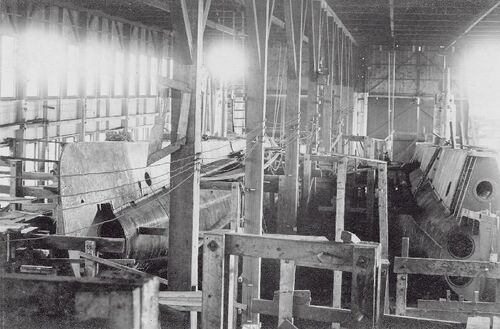
This photo of Narwhal construction was taken 10 months later, on February 7, 1909. Rapid progress has been made. The pressure hull is complete and most of the superstructure has been installed. Narwhal is on the left, Grayling is on the right, in a lesser state of completion. On Narwhal, the superstructure curves around the bow to form the stem, but there is a gap between the stem and the beginning of the pressure hull around the torpedo tubes. The rotating bow cap will be installed there.
Photo courtesy of the Submarine Force Library & Museum.
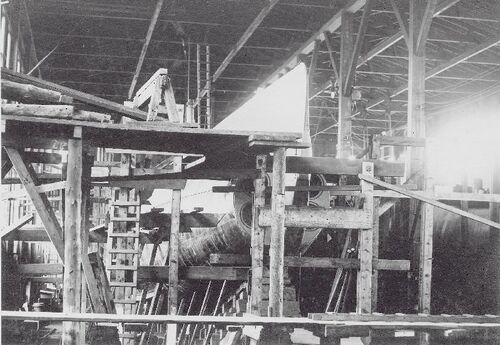
A different view of the same scene above, still with a view of the incomplete bow of Narwhal, February 7, 1909.
Photo courtesy of the Submarine Force Library & Museum.
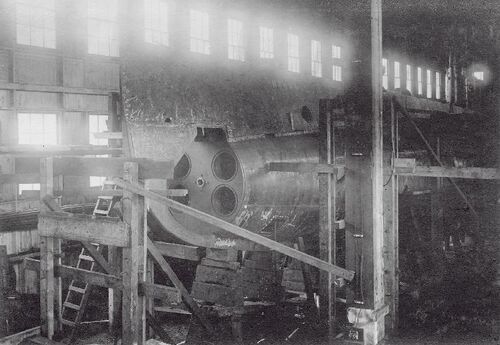
Another angle of the bow area of Narwhal under construction, February 7, 1909. This gives a very clear view of the muzzle end of the torpedo tubes. The streamlined rotating bow cap will be installed later. The cap has two holes in it that will line up with two of the tubes diagonally so that those two tubes can be fired. The cap is then rotated to open up the other two tubes. After firing, the cap is rotated so that the two holes are aligned vertically, and the cap is pulled back and seated firmly so that it seals the muzzle ends of the tubes. The tubes can then be drained and the breech doors inside the torpedo room opened when the boat returns to port. The D-class only carried four torpedoes and no reloads.
Photo courtesy of the Submarine Force Library & Museum.
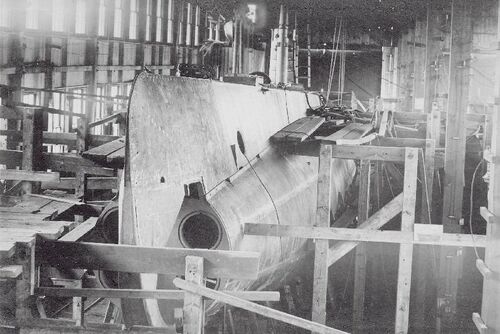
This view of Narwhal's bow while under construction on February 7, 1909 also shows that the conning tower fairwater has been built atop the superstructure in the middle of the boat.
Photo courtesy of the Submarine Force Library & Museum.
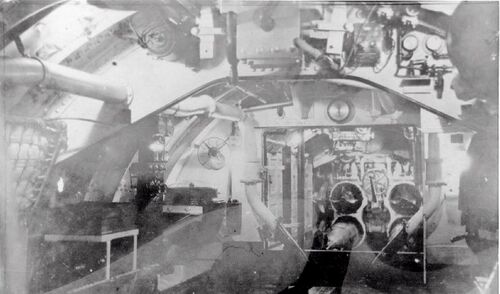
An interior view of Narwhal while under construction at the Fore River Shipbuilding yard in Quincy, MA. This photo was taken on June 12, 1909. The view is from the forward battery area looking forward toward the torpedo room. A large square portion of the torpedo room bulkhead has not yet been installed. See pictures below for what it will look like when complete. The breech doors of the torpedo tubes are open. Yard workers have loaded torpedo "shapes" (inert, non-functioning torpedo simulators) into the tubes to check fit and finish. The two large angled pipes leading upward from the deck right at the bulkhead are battery ventilation pipes that vent hydrogen and heat from the battery while it is being charged. The boat is nearing completion at this point. She would be commissioned five months after this photo was taken.
Photo courtesy of the Submarine Force Library & Museum.
Interior Photos
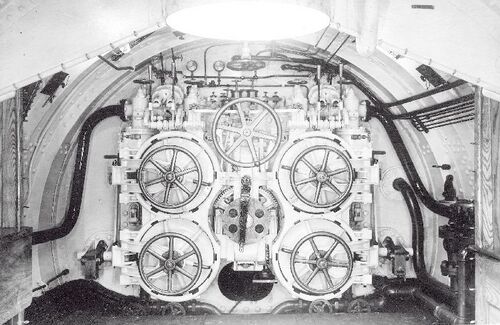
Photo courtesy of the Submarine Force Library & Museum.
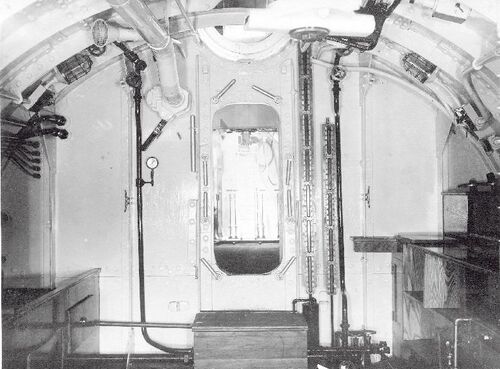
This is Narwhal's torpedo room looking aft. Compared to the photo above, the photographer essentially just turned around. You can see here that the bulkhead that was missing in the construction photo above has now been put into place, with the standard watertight door in the middle. Directly above the door is the circular opening of the angled torpedo loading hatch.
Photo courtesy of the Submarine Force Library & Museum.
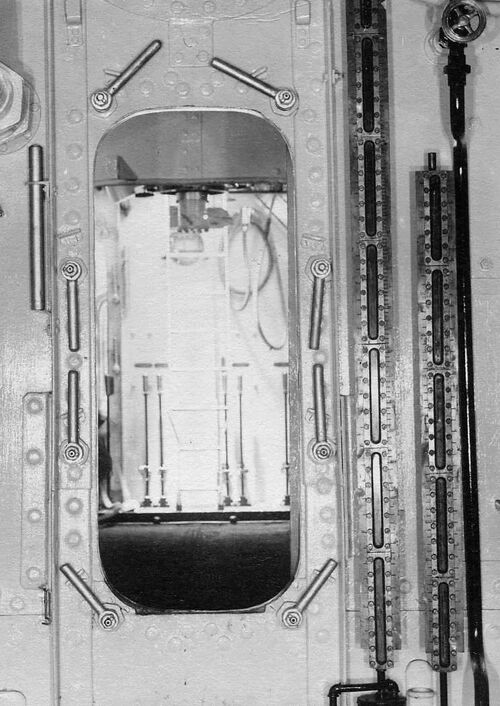
This is a closeup of the photo above, showing the view through the torpedo room watertight door, looking aft into the forward battery compartment and the control room. The ladder seen in the background leads up to the conning tower, and the large levers are for the ballast tank Kingston valves. This view plainly shows that there was not a bulkhead to separate the forward battery from the control room. It was one big compartment.
Photo courtesy of the Submarine Force Library & Museum.
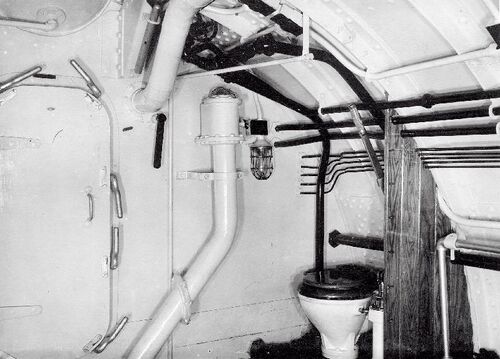
For this photo the photographer stepped through the torpedo room watertight door, turned to the left, then shut the door behind him. This is the forward starboard corner of the forward battery space. On the left is the shut door to the torpedo room, and on the right is the boat's only commode. There is a suspended bar in the overhead that was for a curtain to provide the user of thre commode some level of privacy. The angled pipe against the bulkhead is a battery ventilation line, and it can be seen in the construction photo above that shows the bulkhead missing.
Photo courtesy of the Submarine Force Library & Museum.
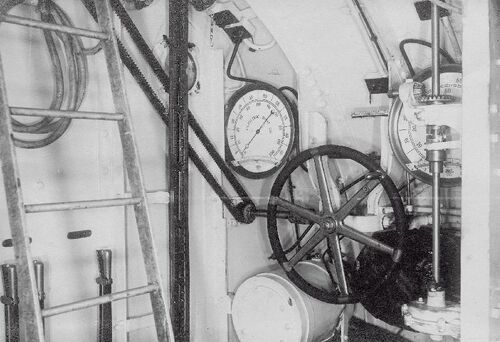
This is the aft end of the Narwhal's combined control room and forward battery space. This view is looking at the aft port corner. The large wheel is the stern planes control station. The chain leads up to rod that leads back to the aft end of the boat to the stern planes themselves. The D-class only had stern planes so there is only one wheel. Two depth gauges are on either side of the wheel. On the left is the ladder leading up to the conning tower. Behind the ladder are the levers for operating the ballast tank Kingston valves.
Photo courtesy of the Submarine Force Library & Museum.

For this photo the photographer has stepped back a few steps so that he could image the periscope eyepiece. This was a non-retractable periscope, but was able to rotate the field of view by turning the large handwheel at the bottom. This instrument was a 4-inch diameter model made by Electric Boat.
On the left of the photo is the open watertight door leading through the bulkhead to the after battery compartment.
Photo courtesy of the Submarine Force Library & Museum.
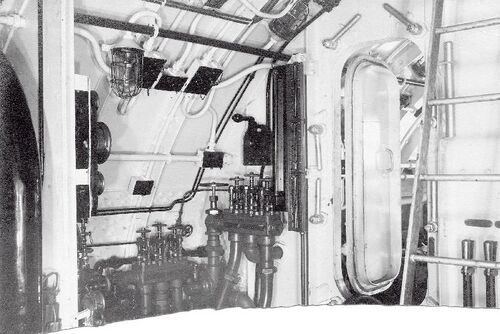
This view is looking aft and to starboard in the control room. On the right is the ladder to the conning tower. In the middle is the door to the after battery compartment. To the left of the door are the high-pressure air and ballast trim mainifolds.
Photo courtesy of the Submarine Force Library & Museum.
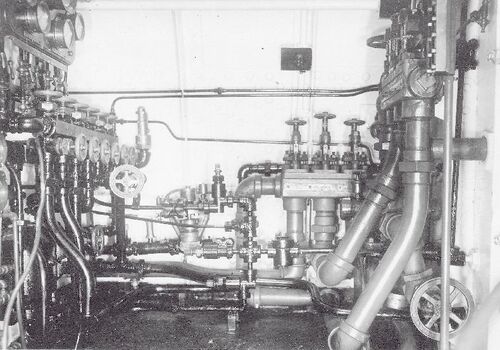
This is a better view of Narwhal's high pressure air and ballast trim manifolds in the starboard aft corner of the control room.
Photo courtesy of the Submarine Force Library & Museum.

This photo was taken in the after battery compartment looking forward. This is the helm wheel. Very unusually, the designers placed it in the after battery compartment. The placement of the wheel here was dictated by the desire to have a watertight bulkhead separating the control room from the after battery. With the other equipment that was in the control room (stern planes control, ballast control, periscope station, etc.) the helm wouldn't fit so they placed it here. The mirror was used by the helmsman to see the dial of the magnetic compass that was above his head. The handwheel was connected to the steering shaft seen in the upper right by the geared belt and the rudder could be turned completely by hand if necessary, but there was also an electric assist motor in front of the helm (seen here painted black). The horn above the mirror was a voice tube that allowed the helmsman to speak with the Officer of the Deck in the control room or on the bridge.
The second half of the boat's battery would be underneath the helmsman's feet, under the deck.
Photo courtesy of the Submarine Force Library & Museum.
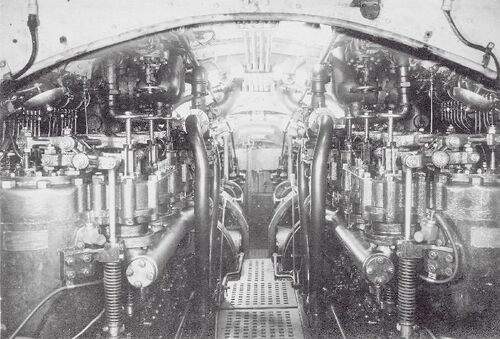
The next compartment aft is the engine room. This compartment is separated from the after battery compartment by a watertight bulkhead. This large compartment contains not only the EB/Craig gasoline engines, but also the clutches, the dynamo generator/motors, and the air compressors. This view is looking aft from the forward end of the compartment.
Photo courtesy of the Submarine Force Library & Museum.
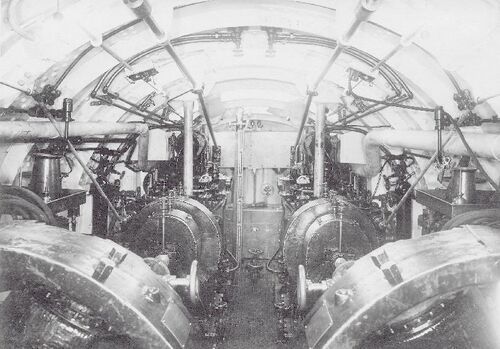
This is a little further aft in the engine room, showing the clutches in the foreground, and the motor/generators further aft.
Photo courtesy of the Submarine Force Library & Museum.
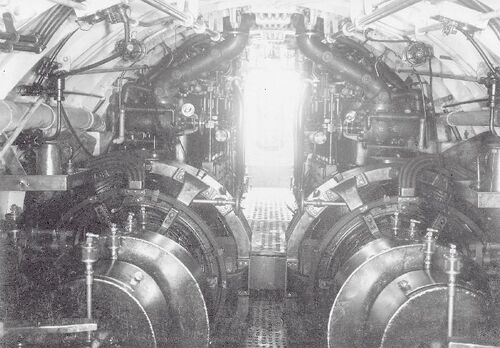
This is from the aft end of Narwhal's engine room looking forward. The motor/generators are in the foreground, then the clutches, and finally the engines. Faintly seen in the far background is the watertight door leading to the after battery compartment. It is somewhat drowned out by light.
Photo courtesy of the Submarine Force Library & Museum.
In Service

Photo courtesy of the Massachusetts Digital Commonwealth.
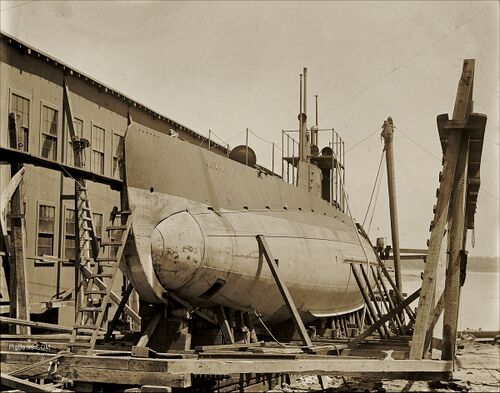
Narwhal is seen here hauled out on the marine railway, right next to the shed where she was built at the Fore River Shipbuilding Company, Quincy, Massachusetts. The boat looks very new so this may have been a post-builder's trials haul out to fix issues found on the trials. This would place the date sometime in the summer or fall of 1909, but it could be any time before 1911. The bow cap for the torpedo tubes is very apparent in this photo, especially compared to the construction photos above. At the bottom of the hull just behind the bow cap there is an access plate that has been removed. This would lead into the forward trim tank. There was likely some sort of repair that needed to be done inside the tank. There is also an air or water hose connected to a fitting just aft of the access hole.
Photo courtesy of the Boston Public Library Print Department.
USS Narwhal (Submarine No. 17) crew muster for April 15, 1910. Data is incomplete due to missing or lost records.
| Townsend, Julius C. - Lieutenant - age 29 - Born: Missouri |
| Beisel, Fred C. - Midshipman - age 24 - Born: Illinois |
| Allen, Charles L. - CGM - age 27 - Born: Indiana |
| Davis, Fred - GM 1c - age 28 - Born: New York |
| Milligan, Joseph A. - GM 2c - age 23 - Born: North Carolina |
| Demont, Charles - GM 2c - age 23 - Born: Minnesota |
| Crilley, Lawrence - GM 3c - age 22 - Born: New Jersey |
| Powers, Richard J. - CMM - age 28 - Born: Connecticut |
| Bottleberghs, Frank J. - MM 1c - age 27 - Born: Belgium |
| Grisler, Charles A. - MM 1c - age 31 - Born: Pennsylvania |
| Herbert, John T. - MM 2c - age 21 - Born: Maryland |
| Miller, Ariel W. - MM 2c - age 22 - Born: Massachusetts |
| Kapp, Ernest E. - CEM - age 27 - Born: North Carolina |
| Blood, Walter H. - EM 1c - age 27 - Born: Pennsylvania |
| Peterson, Lars O. - EM 2c - age 22 - Born: Sweden |
| Lyons, William L. - EM 2c - age 25 - Born: Missouri |
Thank you to Linda Talbott of the US GenWeb Census Project® for providing this information.
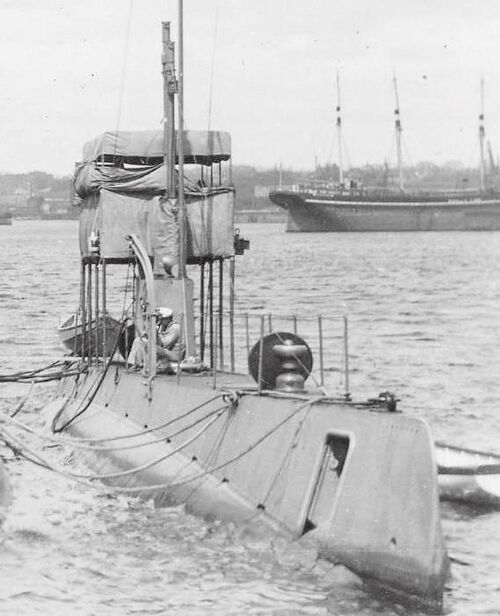
D-1 moored at either the 79th Street or 135th Street piers in New York City, circa 1915. The rectangular opening in the forward superstructure is for a standard navy stockless anchor, and addition to the boat's normal keel mounted mushroom anchor. This modification was unique to D-1. The pipe frame and canvas bridge structure is in place over the conning tower fairwater, and there is a small dinghy on the aft deck.
Photo of the Submarine Force Library & Museum.
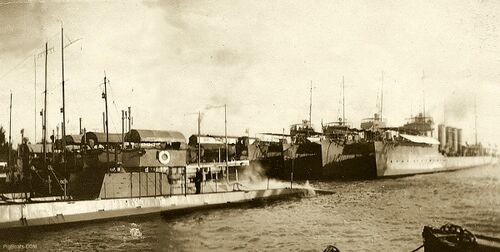
D-1 moored in a nest of other submarines, with four 1000-ton four stack destroyers, probably Cassin-class ships, moored behind them. The location is likely at the Norfolk Navy Yard in Virginia, but it could be at any large Navy facility on the east coast. This is likely a wartime photo, 1914-1917. The D-1 seems to have at least one engine lit off, there is smoke coming from her muffler. This photo is actually the marriage of two photos in the Monroe County Library's collection. They were merged in the area of the life ring on the D-1 to show the whole scene.
Photos courtesy of the Monroe County Library Collection.
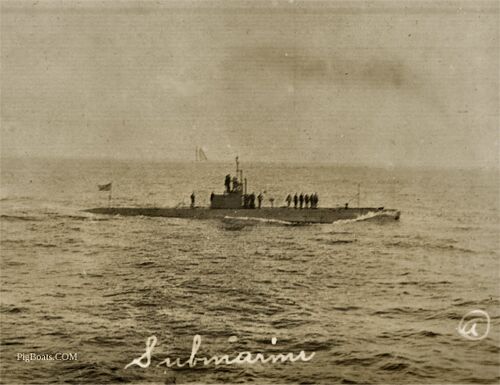
D-1 underway off the New England coast, 1919-1920. By the time of this photo, D-1 had been re-engined with two 120-V4FS diesels, eliminating the noxious and dangerous Craig gasoline engines. A two masted schooner is barely seen in the haze in the background. About 12 or 13 crew are seen on deck which is just about the whole crew complement. There are probably one or two men below to run the engines.
Photo in the private collection of Ric Hedman.
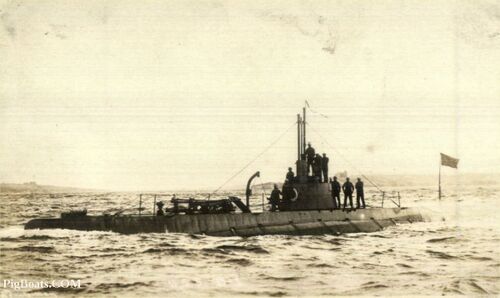
D-1 somewhere in transit along the U.S. east coast, approximately 1919. The purpose of the framework on the forward deck is unknown. It is sitting between the open torpedo loading hatch and the Allied Signal Bell. There is a bit of a swell running as the D-1 noses into a wave.
Photo in the private collection of Ric Hedman.
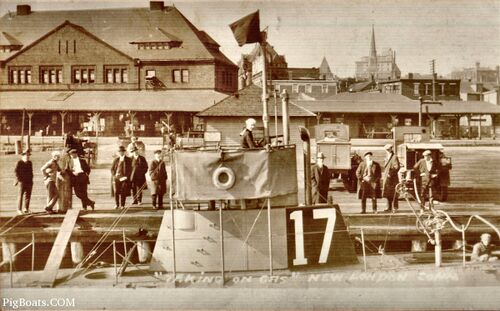
A really nice photo of the D-1 moored behind the train station, at the foot of State Street, in New London, Connecticut. The caption on the photo describes what is happening. "Taking on Gas". The date of the photo is likely late 1920 or early 1921.
The tall church spire in the background is the First Congregational Church at the corner of State and Union. On the pier side to the right of the conning tower fairwater are two gasoline trucks, the right most is delivering gas to the submarine and the other is probably standing by to take over when the first has pumped their fuel into the submarine.
The dark flag flying at the top of the #2 periscope is probably a homemade red "Bravo" flag signaling to those around that a fueling operation is going on.
On January 25th, 2024 at 1:29 PM the steeple of the church, seen above, collapsed into the building destroying the 174 year old church, built in 1851. The church was currently owned by Engaging Heaven Church but still shared with the First Congregational Church. The remaining structure is being demolished. This landmark is now gone.
Photo in the private collection of Ric Hedman.
Page created by:
Ric Hedman & David Johnston
1999 - 2023 - PigBoats.COM©
Mountlake Terrace, WA, Norfolk, VA
webmaster at pigboats dot com
